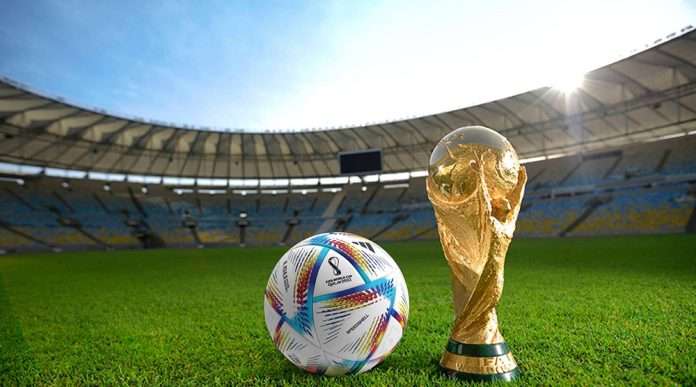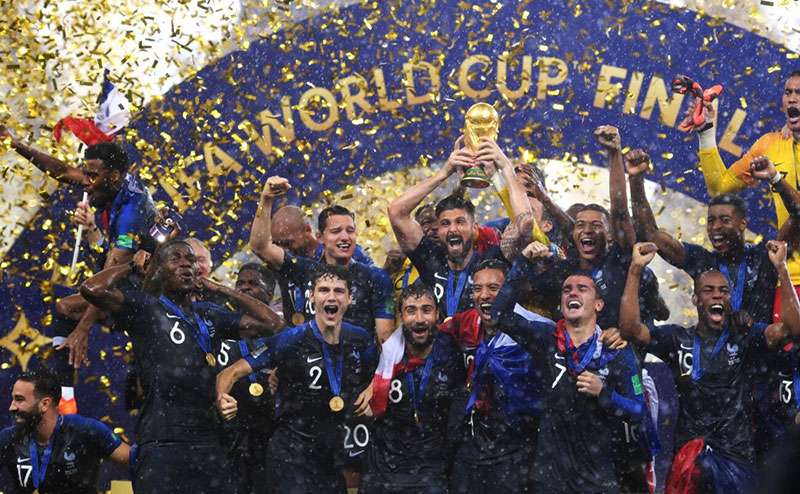World heads to Qatar for the 2022 FIFA World Cup, as one of the biggest sporting events in the world and the most anticipated international football tournament, kicks-off at the Al-Bayt Stadium in Doha. The event, which is the first to be held in the Middle-East and the Arab World, is set to reignite fervor in what is already the most played and most watched game in the region and around the world. On this momentous occasion we take a look at FIFA, the World Cup and its evolution over the years.
FIFA, or to give its name in full, the Fédération internationale de Football Association, which translates to the International Federation of Association Football, was founded in 1904 to oversee international competitions among a handful of European nations. The organization has since grown to encompass 211 national associations that are grouped in one of six regional confederations.
Today, FIFA is the international governing body for association football — the game we know as football or soccer — as well as two other variants of the game: Beach football, which is essentially football played on a beach or sandy pitch, and futsal, which is football played with fewer number of players on a smaller hard court, usually indoors.
FIFA is tasked with organizing and promoting association football’s major international tournaments, notably the World Cup, which commenced in 1930 and the Women’s World Cup which kicked-off in 1991. Contrary to what some people believe, FIFA is not responsible for setting or changing rules of the game, as this is the prerogative of the International Football Association Board (IFAB), of which FIFA is a member.
Just for the record, IFAB founded in 1886, has, aside from FIFA, just four other member organizations to set rules for a game played by millions of people around the world. Nevertheless, the only four other organizations besides FIFA, on the board of IFAB are the pioneering four football associations of UK — England’s Football Association (FA), the Scottish Football Association (SFA), the Football Association of Wales (FAW) and Northern Ireland’s Irish Football Association (IFA). The four associations are granted this privilege in recognition of association football’s origin in the United Kingdom.
Back to FIFA and the World Cup; according to FIFA, members of the organization compete every four years for the title of World Cup Champion. The first FIFA World Cup championship was held in 1930 and follow-up tournaments have been held every four years since, with the exceptions of 1942 and 1946 due to World War II.
The FIFA World Cup is widely considered the most-watched sports event on the planet thanks to record-breaking viewership numbers including more than 3.5 billion viewers—roughly half the world’s population — during the 2018 finals tournament. France emerged as the final victor of the 2018 FIFA World Cup, which took place in Russia. Qatar is hosting the 2022 FIFA World Cup from November 21 to 17 December, while the 2026 tournament will be jointly hosted by Mexico, Canada, and the United States. Mexico, which has previously hosted two World Cup games, will now become the only nation so far to host three games.
FIFA members, selection of finalists: FIFA’s 211-member roster includes more nations than that of the United Nations, which has193 countries plus two observer states as of 2021, or the International Olympic Committee, which has representation from 206 countries as of 2021. So how is it that FIFA has more nations than that recognized by the UN? Well, this is due to FIFA’s definition of nationhood, which is slightly more flexible than that of the UN. For example, the United Nations treats the UK as a single country, but FIFA divides it into four ‘national’ teams: England, Northern Ireland, Scotland, and Wales. Similarly, territories such as Puerto Rico and Gibraltar may not be considered full countries by the UN, but are nevertheless full national members of FIFA.
Any FIFA member is allowed to apply to host the FIFA World Cup, though smaller or less developed countries may find the criteria quite challenging to meet. Qualifying for the FIFA World Cup finals tournament is a significant accomplishment in and of itself thanks to the sheer size of the competition. The initial field for the 2022 FIFA World Cup included 211 teams from each of the member countries, this was then narrowed down to 32 over three years through qualifying matches that began in 2019. The 32 finalist teams will now compete in the World Cup 2022 in Qatar. However, the 2022 tournament will be the last one to include 32 finalists, as FIFA has announced the finals will expand to include 48 teams in time for the 2026 tournament.
Slot allocation for the 2026 FIFA World Cup: Africa: 9 teams (up from 5); Asia: 8 teams (up from 4); Europe: 16 teams (up from 13); North and Central America: 6 teams (up from 3); Oceania: 1 team (up from 0); South America: 6 teams (up from 4); Play-in/Wild card slots: 2 teams
FIFA World Cup host countries: FIFA’s process for choosing host countries has evolved considerably over time. Initially, the process of selecting a host country proved controversial because of the inefficiency of international travel. Few European teams made it to the inaugural FIFA World Cup in Uruguay (South America), and multiple South American teams withdrew when the next two events were held in Europe. To prevent any impression of favoritism, FIFA began to alternate between the Americas and Europe with each successive event. It continued this policy until 2002, when Japan and South Korea co-hosted Asia’s first World Cup finals.
FIFA’s selection process has evolved considerably from those early days, facilitated no doubt by the growth in air travel, making for a much more balanced and trustworthy system. The process starts with each prospective host country submitting a bid to FIFA’s Bid Evaluation Task Force (BETF) many years in advance — for example, bids to host the 2026 World Cup were due by 15 October, 2017.
The BETF then prepares three reports:
Compliance Assessment — Examines the bid’s compliance with FIFA bid requirements, hosting templates, and requirements for the competition.
Risk Assessment — Evaluates the bid’s projected cost and revenue, as well as any possible human rights concerns that could arise from hosting the tournament in the candidate country.
Technical Evaluation Report — Examines details of infrastructure and logistics, such as available stadiums, housing, and transportation, as well as additional financial concerns (costs, estimated broadcast and ticket revenues, etc.) not covered in the Risk Assessment.
These reports are presented to the FIFA Council, which narrows the bids into a shortlist of candidates, which are then voted upon by the entire FIFA congress, which includes representatives from all 211 FIFA member associations. Every step of the process is fully transparent and publicly available, from the initial reports to each member’s final vote.
Every FIFA World Cup host country through 2026 (chronological):
2026: Canada, United States (2nd time), Mexico (3rd time)
2022: Qatar
2018: Russia
2014: Brazil
2010: South Africa
2006: Germany (2nd time)
2002: Japan/South Korea
1998: France (2nd time)
1994: United States
1990: Italy (2nd time)
1986: Mexico
1982: Spain
1978: Argentina
1974: West Germany
1970: Mexico
1966: England
1962: Chile
1958: Sweden
1954: Switzerland
1950: Brazil
1946: — canceled (World War II) —
1942: — canceled (World War II) —
1938: France
1934: Italy
1930: Uruguay
So, now that you know as much, if not more than us, about the FIFA World Cup, grab a ticket and head over to the Qatar World Cup 2022.


















